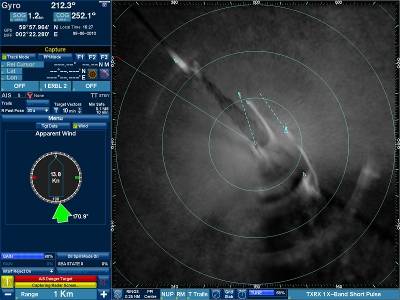The recently launched Oil Spill Radar by Consilium Marine & Safety was tested together with the Norwegian Coastal Administration and the Norwegian Clean Seas Association For Operative Companies (NOFO). Within months since the successful tests last July, the Consilium Oil Spill Detection Radar is celebrating a breakthrough by responding to an increasing demand. The Oil Spill Detection Radar is being used on the Finnish Icebreaker Kontio, commissioned as stand-by Vessel for EMSA (European Maritime Safety Agency), and by customers in Norway, Italy and China, as well as the most recent order for an Oil Spill Response Vessel for cleaning operation in the harbor of Rotterdam. In addition, Consilium Oil Spill Detection radar has received the 2010 Vespucci Award for the Innovation Category. The Vespucci Award (www.premiovespucci.org), sponsored by the Tuscany Region Government, the Italian Industries Association (Confindustria) as well as other international sponsors, is seen as an acknowledgement of the innovation in creating a new premium product.
The key feature of the Oil Spill Radar is said to be the possibility to integrate a complete Oil Spill Detection function into Consilium’s standard type approved IMO/Solas Navigational radar. Furthermore, the new advanced radar processing unit is supported by a special Consilium radar sensor and by its capability to increase the rotation speed of the antenna to up to 44 revolutions per minute.
As a result, ships in regular operations can use the primary radar set as a traditional instrument for navigation and the secondary radar display, interfaced to the primary radar, switched to the advanced function of Oil Spill Detection. Using both radar display functions simultaneously, the vessel acts as an efficient early warning anti-pollution unit while sailing along its route. For dedicated Oil Spill Response Vessels, the stress on the officer is reduced by the fact that he can operate on the same user-friendly graphical man-machine interface.
From the ship-owners’ point of view, the most important benefit is the reduced maintenance costs in terms of installation, service and spare parts, due to the fact that Consilium is represented by local offices in 18 countries worldwide for both navigational bridge equipment and Oil Spill Detection systems.
Thanks to advanced real-time signal processing, the Consilium Oil Spill Detection Radar is able to highlight the dampening of the reflected microwave radiation on the radar display and to overlay the same on the Consilium ECDIS. This integration is allowing Consilium to offer an integrated oil spill response and management bridge system.
When discussing microwave energy propagation and scattering, the polarization of the radiation is an important property. Although imagery in both vertical and horizontal polarizations can be used for slick detection, the vertical imagery is preferred for dedicated oil spill radar sensors as, in general, it offers a stronger clutter background than other polarization choices, generating an improved contrast with the oil contaminated areas. However, in spite of the fact that vertical polarizations are more sensitive than horizontal for slick detection, there are only disadvantages in their use for navigational radars.














